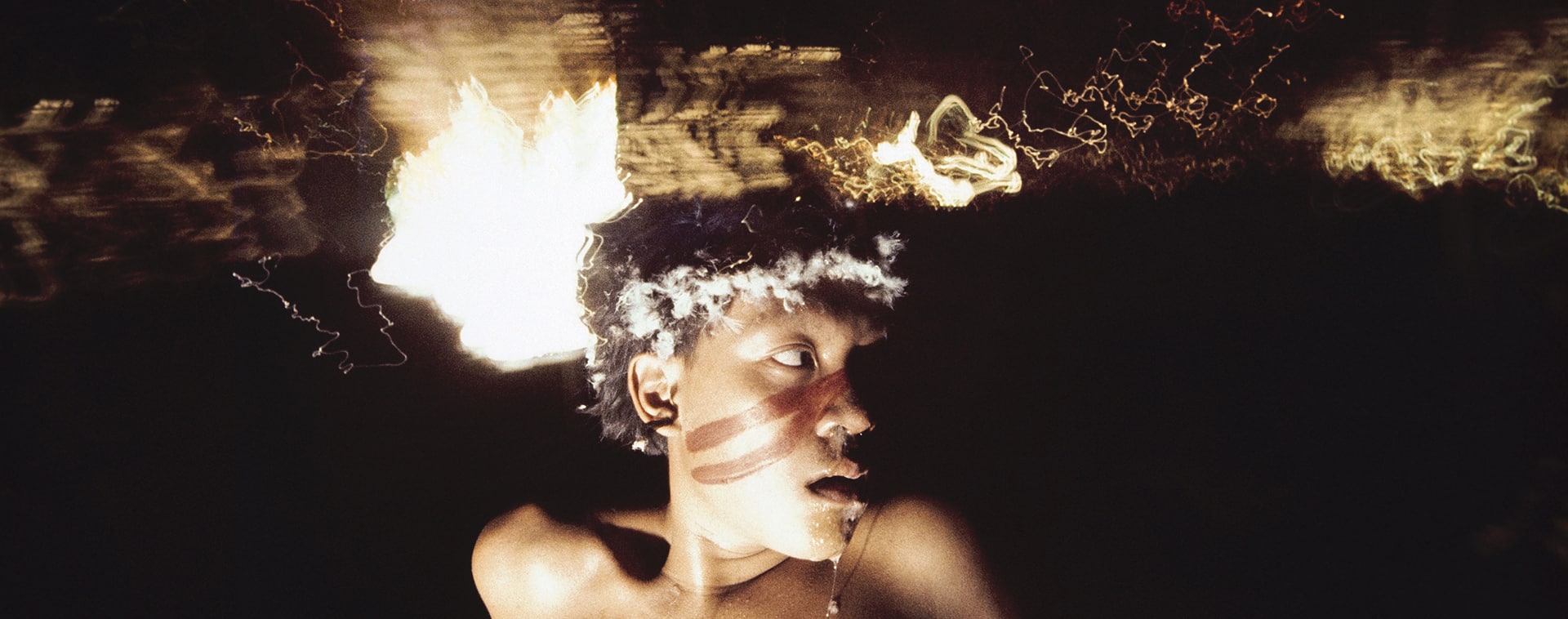
The young Susi Korihana thëri swimming, infrared film, Catrimani, Roraima, 1972–74. © Claudia Andujar
In order to capture these moments, the photographer had to fully integrate the life and customs of the Yanomami Indians in Brazil’s Amazon rainforest, sharing their food, their way of life and their way of thinking without hesitation. At the age of 88, she has become such a part of their family that one of them, at the opening for the press in Paris, went so far as to say that she is “a mother” to them, that she has enabled them to show the world the face of their threatened community and the hardships they suffer because of the invasion of the goldpanners, i.e. the gold prospectors who eat up their land with the blessing of the current Brazilian authorities.
This work by Claudia Andujar is on its way to becoming mythical. It is the voice of a people in danger and the account of a way of life that is extremely different from world standards and the capitalist and consumerist way of life that prevails across most of the globe. This work is all the more precious and meaningful given that it comes from the gaze of a free-thinking woman with an absolutely astonishing, inventive aesthetic that breaks with the conventions of traditional photography almost entirely.

Areas of shadow
In order to assess the innovative scope of Andujar’s work, it is no doubt necessary to provide context. The photographer produced these images in the 1970s and 1980s. At the time, photographic experimentation was not common, especially in the field of documentary photography. But Claudia Andujar did dare to experiment. She uses infrared film that gives a pink tint to her photographs, as if they have come from an unreal, secret and beautiful world, which most human beings will never know. Because of this strangeness, the images are particularly striking. They fuel the viewer’s imagination about life in the forest, about living in the middle of trees and animals, making such a life seem enviable and easy.
Claudia Andujar also loves black and white. Here too though, her work is anything but classical. In most of her photographs, she likes to include blurred outlines and dark areas. She cultivates the feeling that comes before strange Yanomami rituals: secrecy. Beings never fully or clearly appear. They pass by like specters caught in a dance, in full motion, ones that the camera never manages to capture completely. “The forest is dark to begin with, but when the sky is overcast and it rains, it becomes even darker,” says the photographer, who has so successfully captured this feeling of oppressive darkness.

Hallucination
Without doubt, the violence of the photographic act—some don’t hesitate to say that the photographer “steals the soul” of the subject— is deliberately mitigated here by Claudia Andujar. The photographer seems to lightly touch her subjects, almost caress them, so as to never be final or imprison them in a particular image. Her photographs are the very opposite of the cold, impersonal identity photographs required by a country’s officials. They are solar, engaged, imperfect. Feverish.
They are also immersive. They are the surest witness of Andujar’s gaze, where emotion mingles with the love she has for this people. When she documents the reahu ritual, during which participants ingest hallucinogenic substances, she plays with the shutter speed and the flash of her camera, populating her images with streaks of light that accentuate the state of trance the Indians have entered. She too seems to be hallucinating, but it is during a luminous, collective and ritualized hallucination, a far cry from the dark and dangerous aspect of individual hallucinations achieved in a society that represses them.

Slides from the audiovisual projection, 1989/2018 © Claudia Andujar
Numbered
But Claudia Andujar does also use the conventions of classical photography. In a unique series, she has taken black and white portraits of Indians in the purest tradition of portraiture. Nevertheless, there is always a depth to her blacks, as if they were engulfing a part of the people being photographed. She event went so far as to produce portraits by modulating the light, in order to signify the threat of disappearance that hangs over these people.
If Claudia Andujar abandoned photographic experimentation in favor of more classic portraiture, it was also because she incorporates disturbing and thought-provoking elements into it, as seen in another series of portraits, where she asked the Indians to pose with a necklace bearing a number. These numbers are the ones used by the authorities to vaccinate the Yanomami and prevent them from dying off in an epidemic. But because of the way they’re presented, they primarily come across as accessories in the service of a discriminatory policy that pays no heed to the identity or history of the person, and which recalls other such policies, namely the Jewish star imposed by the Nazis, which Claudia Andujar herself had to wear when she was a child in Europe.
The photographer’s entire aesthetic is thus a gesture of tenderness towards the Yanomami people. It comes from both stylistic audacity and human engagement, which feed off and complement each other. By showing the lives of those she cherishes, Claudia Andujar has invented a language, her own language, which is deeply affecting to this day and expresses just how much inventiveness in art is related to the friendship one has with one’s subject.

Unahi Opiki thëri, Roraima, 1974. © Claudia Andujar

MARCADOS, 1981-1984 Ericó, Roraima, 1983. © Claudia Andujar

MARCADOS, 1981-1984. Aracá, Amazonas/Surucucus, Roraima, 1983. © Claudia Andujar

Antônio Korihana thëri, a young man under the effect of the hallucinogen yãkoana, Catrimani, Roraima, 1972–76. © Claudia Andujar
By Jean-Baptiste Gauvin
Claudia Andujar – The Yanomami Struggle
Through May 10, 2020
Fondation Cartier
261 boulevard Raspail, 75014 Paris


